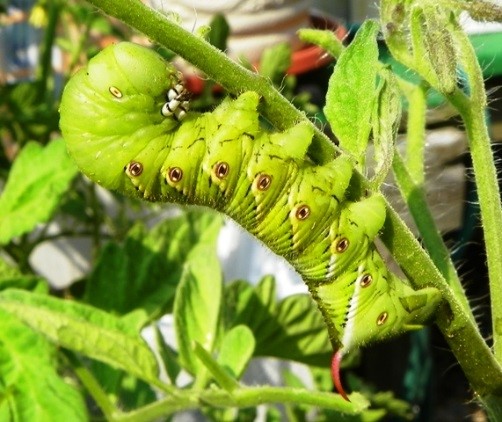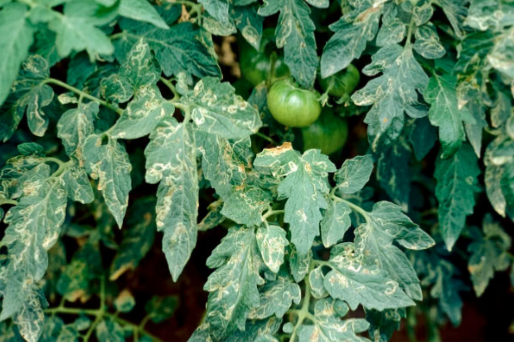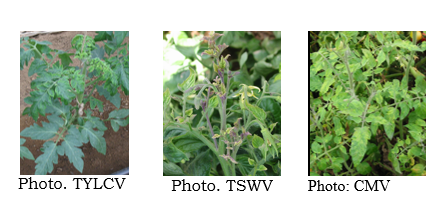Tomatoes
Pests and Diseases
6.1 Tomato pests
6.1.1.Aphids (Aphididae)
- Can be controlled by spraying with Dimethoate 20 WP at the rate of 34 g in 14 litres of water for knapsack sprayer or 34g in 1 litre of water for ULV sprayer



6.1.2. Caterpillars
- Should be controlled by spraying with carbaryl 85 WP, 35 g in 14 litres of water for knapsack sprayer or in 1 litre of water for ULV sprayer.
6.1.3. Root knot nematodes
- These are galls and swellings on the roots causing stunting of the plants and eventual death.
- Control by
- Good agricultural practices and chemicals are used
- Planting nematode free seedlings
- Fertilizers as Plant Guard helps through facilitating production of beneficial microbes and help in production of new root hairs to substitute the damaged / infected ones.
- Nematodes can be controlled by using a 5-year crop rotation with crops such as maize and Rhodes grass
- Nematicides such as Carbofuran (Furadan) at the rate of 4 g per plant may be used.
NOTE: Nematicides are toxic, farmers wishing to use them should therefore get assistance from agricultural field staff.
6.1.4. Red Spider Mite
- The tomato red spider mite, (Tetranychus evansi, Baker and Pritchard), is a serious pest of solanaceous crops in Malawi.
- Spider mites prefer the undersides of leaves, but in severe infestation will occur on both leaf surfaces as well as on the stems and fruits.
- They multiply very fast they are able to destroy plants within a short period of time.
- Spider mites spin silk threads that anchor them and their eggs to the plant.
- The fine web produced by spider mites protects them from some of their enemies and even from pesticide applications.
- RSM are usually clusters of yellow spots on the upper surface of leaves, which may also appear chlorotic.
- This gives the leaf a speckled or mottled appearance
6.1.4.1. Management
- Site nurseries away from infested crops and avoid planting next to infested fields.
- Grow healthy crops; avoid water and nutrient stress. Apply mulch and incorporate organic matter into the soil to improve the water holding capacity and reduce evaporation
- Keep perennial hedges such as pigeon peas, they are said to encourage predatory mites, which predate on spider mites.
- Uproot and burn infested plants. This can be successful during the early stages of infestation when the mites concentrate on a few plants.
- Keep the field free of weeds.
- Remove and burn infested crop residues immediately after harvest
- When moving through the crop for weeding, pruning, harvesting or any other field work, always leave the infested area until last in order to minimize the spread of mites on clothing or farm tools
NOTE: Mites favor dry and hot conditions. Influencing the microclimate by reducing the planting distance is reported to suppress spider mite populations. However, this could also enhance fungal diseases, so care should be taken.
6.1.5. Whiteflies
- Whiteflies attack tomatoes from seedling to mature stage.
- Feeding of whiteflies causes yellowing of infested leaves.
- The main damage caused by whiteflies is indirect as vectors of virus diseases. Bemisia tabaci transmits several virus diseases in tomato.
- It is vector of the Tomato Yellow Leaf Curl Virus (TYLCV).
6.1.5.1. Management
- Time sowing and transplanting. If possible avoid the season when whiteflies are more likely to occur
- Remove weeds in advance of planting tomatoes, and keep tomato fields weed-free.
- If necessary spray Neem extracts. Neem-based insecticides are reported to substantially reduce egg laying by B. tabaci, inhibit the growth and development of nymphs, and significantly reduce the risk of TYLCV transmission.
- Plant barrier crops.
6.2 Tomato diseases
6.2.1. Bacterial wilt (Ralstonia solanacearum)
- The disease causes rapid wilting and death of the entire plant without any yellowing or spotting of leaves
- Total collapse of the plant usually occurring when temperatures reach 32°C and above.
- Plant wilts while still green.
- When the stem of a wilting plant is cut across, the pith has a darkened water-soaked appearance, and on squeezing the cut stem, a white, yellow or greyish, slimy exudate may appear.
- In later stages of the disease, decay of the pith may cause extensive hollowing of the stem.
6.2.1.1. Management
- If only a few wilted plants are found, immediately remove them from the field
- Practice long-term crop rotation (3-4 seasons)
6.2.2. Fusarium wilt (Fusarium oxysporum sp. Lycopersici)
- The lower leaves of the plant usually turn yellow and die.
- Leaves on one side may be affected while those on the other side are symptomless.
- Diseased leaves readily break away from the stem.
- When affected stems just above ground level and petioles are cut diagonally, a reddish-brown discoloration of the water conducting tissues will be observed.
- The fungus is both seed- and soil-btorne.
- It causes most damage on light, sandy soils.
6.2.2.1. Management
- Use resistant tomato varieties
- Use certified disease-free seeds
- Do not locate seedbeds on land where Fusarium wilt is known to have occurred
- Where soil is acidic, raise the pH by applying lime or farmyard manure
- Avoid excessive nitrogen fertilization and control root-knot nematodes
6.2.3. Early blight (Alternaria solani)
- Leaf spots of early blight are circular, up to 12 mm in diameter, brown, and often show a circular pattern, which distinguishes this disease from other leaf spots on tomato
6.2.3.2. Management
- Use resistant varieties
- Use certified disease-free seeds. If using own seeds, hot water treat the seeds.
- Use disease-free plants
- Practice roation with non-Solaneceous crops (e.g. eggplant, peppers, potatoes etc)
- Stake and prune indeterminate varieties
- If disease is endemic, applied preventative sprays of copper compounds (e.g. copper hydroxide).
6.2.4. Late blight (Phytophthora infestans)
- Irregular, greenish-black, water-soaked patches, which appear on the leaves.
- The spots soon turn brown and many of the affected leaves wither, yet frequently remain attached to the stem.
6.2.4.2. Management
- Use resistant varieties
- Use disease-free transplants
- Stake and prune indeterminate varieties
- Practice crop rotation
6.2.5. Powdery mildew
6.2.6. Tomato viruses

- Often spread in the plantation by insect vectors such as whitefly, thrips and aphids.
- The most important symptom of viral infections is the light (white or yellow) colour of the leaves, or a mosaic pattern of light and darker shades of green on the leaves.
- Viral disease leads to dwarfed growth, rosette formation or other strange stem and leaf deformations.
Reported Viruses in Tomato
- Tobacco mosaic virus or tomato mosaic virus (TMV or ToMV)
- Cucumber mosaic virus (CMV)
- Tobacco etch virus (TEV)
- Potato virus-Y (PVY)
- Potato leafroll virus (PLRV)
- Tomato spotted wilt virus (TSWV)
- Pepper veinal mottle virus (PVMV)
- Chilli veinal mottle virus (CVMV Or Chivmv)
- Tomato yellow leaf curl virus (TYLCV)
- Tomato Big-Bud mycoplasma (TBB)
6.2.6.1. Management
- Use tolerant varieties and certified disease-free seeds
- Protect seedlings with a net in the nursery.
- Control the insect vector.
- Eliminate weeds and ornamental plants that harbour the virus.
- Remove and destroy infected individual plants.
- Avoid an overlap of tomato crops
- Remove crop refuse and roots from fields
- Workers should not smoke or take snuff when working in tomato fields since the virus can be transmitted from tobacco.
6.2.7. Blossom end rot (Physiological disorder)
- Caused by calcium deficiency and irregular watering.
- The disease occurs at the blossom-end of the fruit.
- Starts as a water-soaked spot that enlarges to become dark brown and sunken.
- The surface of the spot becomes dark and leathery.
- The rot is dry.
6.2.7.2. Management
- Avoid water stress during early stages of fruit development
- Apply lime in calcium deficient soils
- Apply foliar sprays of 0.5% calcium chloride at fruit development stage.
